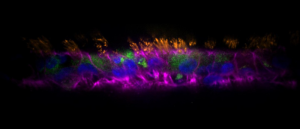The metabolic pathway underlying eye development

Scientists discover the important role that aerobic glycolysis, the process where cells make lactate from glucose, plays in mammalian eye development.
Although already known to be used by retinal cells for cell differentiation, lactate’s exact role in early eye morphogenesis was not previously understood. Now, a team led by researchers from Northwestern University (IL, USA) reports that aerobic glycolysis is necessary for the early stages of retinal development.
To identify how the eye starts to form in mammals, first author Nozomu Takata developed embryonic stem cell-derived eye organoids as well as observed the optic vesicle territory of embryonic mice. When observing the mice, Takata found that early mouse eye progenitors showed high levels of glycolytic activity and lactate production. When he introduced a glycolysis inhibitor to the eye organoid, normal optic vesicle development was blocked; however, eye development resumed when lactate was added back to the organoids.
Takata and his collaborators used genome-wide transcriptome and epigenetic analysis using RNA and ChIP sequencing to compare the organoids to controls. By inhibiting glycolysis and adding lactate to the organoids, the research team found that the expression of certain key and evolutionarily conserved genes was regulated, a process essential for early eye development.
 Airway to AirGel: the new in vitro respiratory model
Airway to AirGel: the new in vitro respiratory model
A new organoid model platform has been added to the growing arsenal of tools with which to investigate respiratory conditions.
To validate these findings, Takata deleted two genes known to regulate glucose transport and lactate production in the developing retinas of mouse embryos, Glut1 and Ldha. Deleting these genes halted normal glucose transport in the eye-forming region. Takata explained, “what we found was an ATP-independent role of the glycolytic pathway. Lactate, which is a metabolite known as a waste product before, is really doing something cool in eye morphogenesis.”
Using tools such as mouse genetics and stem cell-derived organoids, Takata plans to continue his study of how the glycolytic pathway and metabolism impact organ development. The findings from this study can also help scientists understand the possible direct effects that metabolites have on gene expression, organ regeneration and tumor development.
Guillermo Oliver, senior author of the study, concluded, “for many developmental processes, you need very strict transcriptional regulation. A gene is on or off at certain times, and when that goes wrong, that could lead to developmental defects or promote tumorigenesis. Now that we know that there are specific metabolites responsible for normal or abnormal gene regulation, this can broaden our thinking on approaches to therapeutic treatments.”